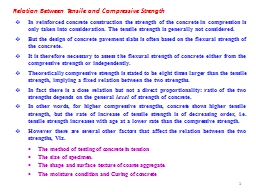

In reinforced concrete construction the strength of the concrete in compression is only taken into consideration The tensile strength is generally not considered But the design of concrete pavement slabs is often based on the flexural strength of the concrete ID: 1021872
Download Presentation The PPT/PDF document "Relation Between Tensile and Compressive..." is the property of its rightful owner. Permission is granted to download and print the materials on this web site for personal, non-commercial use only, and to display it on your personal computer provided you do not modify the materials and that you retain all copyright notices contained in the materials. By downloading content from our website, you accept the terms of this agreement.
1. Relation Between Tensile and Compressive StrengthIn reinforced concrete construction the strength of the concrete in compression is only taken into consideration. The tensile strength is generally not considered.But the design of concrete pavement slabs is often based on the flexural strength of the concrete.It is therefore necessary to assess the flexural strength of concrete either from the compressive strength or independently.Theoretically compressive strength is stated to be eight times larger than the tensile strength, implying a fixed relation between the two strengths.In fact there is a close relation but not a direct proportionality: ratio of the two strengths depends on the general level of strength of concrete.In other words, for higher compressive strengths, concrete shows higher tensile strength, but the rate of increase of tensile strength is of decreasing order, i.e. tensile strength increases with age at a lower rate than the compressive strength.However there are several other factors that affect the relation between the two strengths, Viz. The method of testing of concrete in tension The size of specimen.The shape and surface texture of coarse aggregate.The moisture condition and Curing of concrete1
2. It is difficult to test concrete in direct (uniaxial) tension because of the problem of gripping the specimen satisfactorily (resulting in the premature failure near to the end attachment and eccentricity in the applied load). Direct tensile test is therefore not standardized and rarely used.Therefore alternative methods of determining the tensile strength has been suggested by various codes: The tensile strength in Flexure (Modulus of Rupture) and in indirect tension (Splitting).The different test results yield numerically different results: direct tension<splitting tension<flexural tension. The reasons for this are twofold. First, with the usual size of laboratory specimen, the volume of concrete subjected to tensile strength decreases in the order listed above and there is a greater chance of a ‘weak element’ and therefore of failure in a larger volume than in a smaller volume.Second, both the splitting and flexural test methods involve non-uniform stress distribution, which impedes the propagation of crack, and, therefore delay the ultimate failure. On the other hand, in the direct test, the stress distribution is uniform so that, once a crack has formed, it can propagate quickly through the section of the specimen.2
3. There is little influence of the type of aggregate on the direct and splitting tensile strength, but the flexural strength of concrete is greater when angular crushed aggregate is used than with rounded natural gravel. This is attributed to improved bond between cement paste and aggregate particles.This is because the improved bond of crushed aggregate holds the material together but is ineffective in direct or indirect tension.Since the compressive strength is little affected by the shape and surface texture of the aggregate, the ratio of the flexural strength to compressive strength ( ft/c ) is greater for angular crushed aggregate, especially at higher compressive strengths.The tensile strength of concrete is more sensitive to inadequate curing than the compressive strength. This may due to the inferior quality of gel formation as a result of improper curing and also the effect of non-uniform shrinkage of flexure beams is very serious. Thus air-cured concrete has a lower ft/c ratio as compared to concrete cured in water and tested wet. The compressive strength of drying concrete (wet cured and tested dried) is greater than continuously wet stored i.e. tested in wet condition. The direct and splitting tensile strength are not affected in a similar manner. (Fig. 1)The use of pozzolanic material increases the tensile strength of concrete.The central road research laboratory (CRRI) has established the following relationship between flexural and compressive strength of concrete.3
4. Where, c : compressive strength of concrete, and ft : Flexural strength of concrete4Cube Compressive Strength-MPaTensile Strength-MPa246810102030405060708090100FlexureWetDryDirect (Wet & Dry)Splitting (Wet & Dry)Fig 1